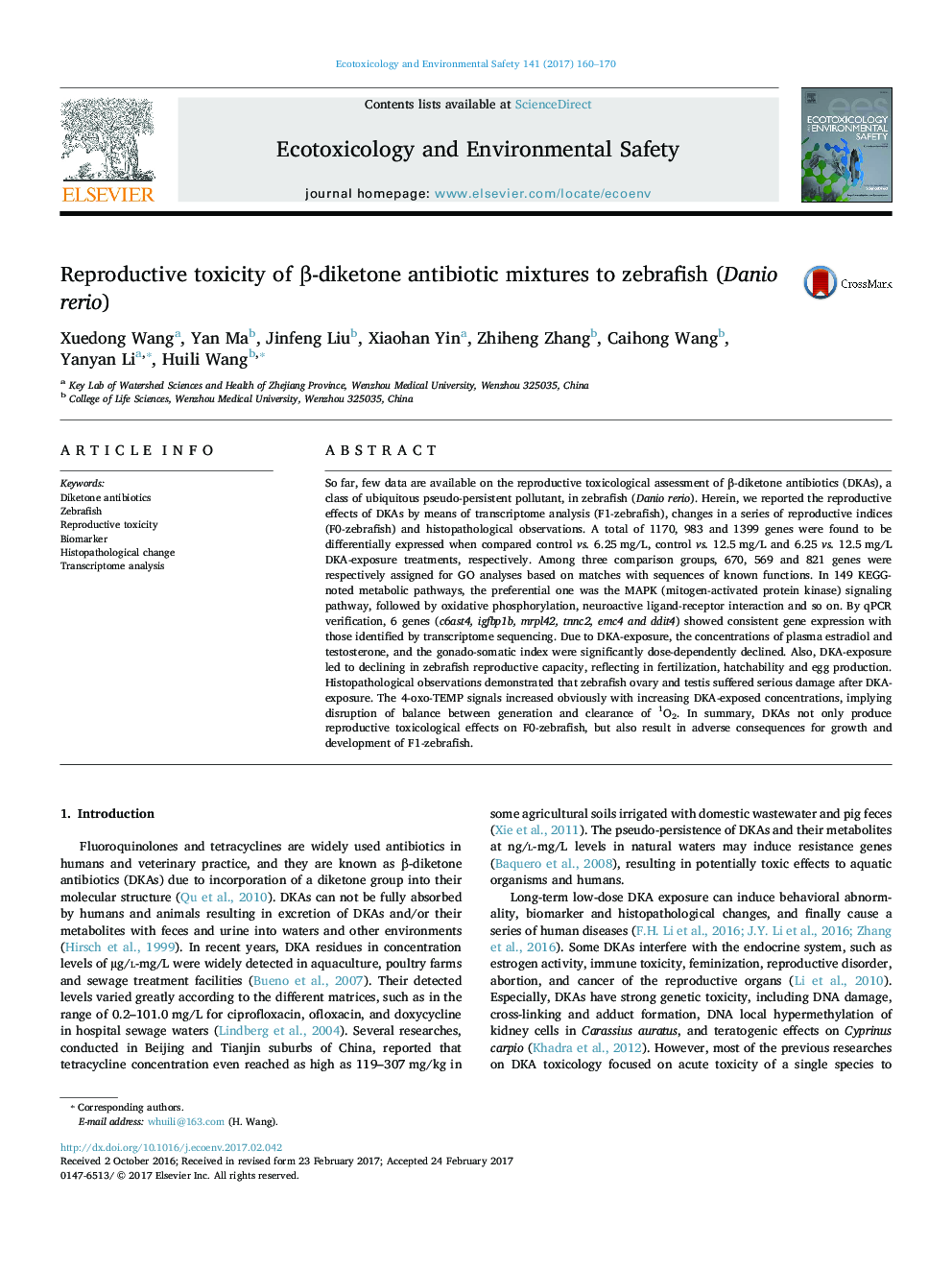| کد مقاله | کد نشریه | سال انتشار | مقاله انگلیسی | نسخه تمام متن |
|---|---|---|---|---|
| 5747902 | 1618923 | 2017 | 11 صفحه PDF | دانلود رایگان |
عنوان انگلیسی مقاله ISI
Reproductive toxicity of β-diketone antibiotic mixtures to zebrafish (Danio rerio)
دانلود مقاله + سفارش ترجمه
دانلود مقاله ISI انگلیسی
رایگان برای ایرانیان
کلمات کلیدی
موضوعات مرتبط
علوم زیستی و بیوفناوری
علوم محیط زیست
شیمی زیست محیطی
پیش نمایش صفحه اول مقاله

چکیده انگلیسی
So far, few data are available on the reproductive toxicological assessment of β-diketone antibiotics (DKAs), a class of ubiquitous pseudo-persistent pollutant, in zebrafish (Danio rerio). Herein, we reported the reproductive effects of DKAs by means of transcriptome analysis (F1-zebrafish), changes in a series of reproductive indices (F0-zebrafish) and histopathological observations. A total of 1170, 983 and 1399 genes were found to be differentially expressed when compared control vs. 6.25 mg/L, control vs. 12.5 mg/L and 6.25 vs. 12.5 mg/L DKA-exposure treatments, respectively. Among three comparison groups, 670, 569 and 821 genes were respectively assigned for GO analyses based on matches with sequences of known functions. In 149 KEGG-noted metabolic pathways, the preferential one was the MAPK (mitogen-activated protein kinase) signaling pathway, followed by oxidative phosphorylation, neuroactive ligand-receptor interaction and so on. By qPCR verification, 6 genes (c6ast4, igfbp1b, mrpl42, tnnc2, emc4 and ddit4) showed consistent gene expression with those identified by transcriptome sequencing. Due to DKA-exposure, the concentrations of plasma estradiol and testosterone, and the gonado-somatic index were significantly dose-dependently declined. Also, DKA-exposure led to declining in zebrafish reproductive capacity, reflecting in fertilization, hatchability and egg production. Histopathological observations demonstrated that zebrafish ovary and testis suffered serious damage after DKA-exposure. The 4-oxo-TEMP signals increased obviously with increasing DKA-exposed concentrations, implying disruption of balance between generation and clearance of 1O2. In summary, DKAs not only produce reproductive toxicological effects on F0-zebrafish, but also result in adverse consequences for growth and development of F1-zebrafish.
ناشر
Database: Elsevier - ScienceDirect (ساینس دایرکت)
Journal: Ecotoxicology and Environmental Safety - Volume 141, July 2017, Pages 160-170
Journal: Ecotoxicology and Environmental Safety - Volume 141, July 2017, Pages 160-170
نویسندگان
Xuedong Wang, Yan Ma, Jinfeng Liu, Xiaohan Yin, Zhiheng Zhang, Caihong Wang, Yanyan Li, Huili Wang,